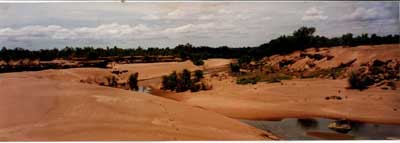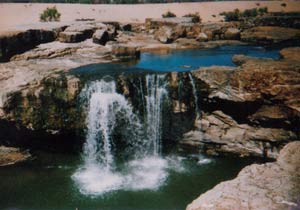 Accommodation | International
Flights | Domestic
Flights | Tours
| Travel
Insurance | Car
Hire | Visas
| Shopping
| Dating
| Humour
Accommodation | International
Flights | Domestic
Flights | Tours
| Travel
Insurance | Car
Hire | Visas
| Shopping
| Dating
| HumourAmazing Australian History
Aborigines have lived in Australia for an estimated 50 000 years but while in other parts of the world people exhausted themselves building Great Walls, pyramids and Taj Mahals, Aborigines happily wandered the plains, slept under trees or if it got really wet built a shelter of tree branches and fan palm leaves.
It is probably for this reason that the first settlers presumed Australia to be 'Terra Nullius' (not occupied by anyone) as there were no fences, roads, houses and all the things normally visible where people live.
Soon after arrival the Poms started building and nowadays the oldest building to be found is a brick cottage in Parramatta, Sydney, that was built in 1793. A lot of the time though Australians expect you to get excited over structures that are only about a 100 years old which is ancient in their eyes but a joke to Europeans who are used to living and shopping in cities with buildings dating back at least 700 years. If you want to see something really old try to see some Aboriginal rock paintings, the oldest ones in the Koonalda cave under the Nullarbor plain are estimated to be 20 000 years old!
Black birding
Many people are surprised to hear that Australia's
history includes the phenomena of "black birding', a local
version of the slave trade that occurred on American plantations
in the early days of settlement there.
When white settlers first started turning the landscape into sugar
cane plantations they found it hard going in the tropical heat and
honestly believed that white people could not work in such circumstances.
While the Dutch were succesful getting Indonesians to work hard
on spice plantations Australian settlers were not so succesful getting
Aborigines to do the same (though they proved their skills as horsemen
and workers on cattle stations). A solution was found in sailing
out to Pacific islands and kidnapping people to bring back to the
cane fields, starting around 1860 at least 800 ships had "kidnapped"
at least 60,000 islanders and sold to Queensland sugar growers.
Though officially they were not slaves the pay was that ridiculous
that they could not afford to return home and thus had little choice
other than to stay and work to survive. The government passed the
Pacific Island Labourerer Act in 1901 to abolish this practice and
by 1906 ordered their repatriation, though not all of them returned
and even nowadays you can see dark skinned people in sugar cane
areas that are not Aborigines but descendants of Pacific Islanders
that decided to stay.
Black war
Aborigines have not fared very well all over Australia since the arrival of Europeans in the 1700's but during the Black War in Tasmania they fared worst of all. In the early 1800's tensions flared that high that martial law was proclaimed by Governor Arthur, which gave soldiers the right to arrest or shoot on sight any Aboriginal found in an area of European settlement. Aboriginal people who fought to retain their land speared shepherds and stock and were subsequently hunted and shot. Between the 1820s and 1840s most Aborigines were relocated to a camp on Bruny Island. Conditions there were terrible and their numbers rapidly declined due to malnutrition and disease and by 1876 Tasmania's last full blood Aborigine died. They had been wiped out so quickly that very little of their history, culture or language had been recorded.
Bombing of Darwin
While Australia has never been invaded in the 200
years or so of white settlement it has had a few visits from the
Japanese army in World War Two.
In february 1942 a Pearl Harbour style attack on Darwin by 188 Japanese
planes killed 243 people and sunk numerous ships. They came back
another 57 times over the next two years doing more damage. You
can still see remains of concrete bunkers and gun turrets in Darwin
and there is a museum in Fannie Bay with war relics. Other places
in Australia received Japanese visits too, there were also air attacks
on some North Queensland and Western Australian towns and mini submarines
attacked Wollongong and Sydney where they managed to sink a ship
in the harbour, the Japs never made it home after that, many years
later their sunken mini submarines were discovered on the ocean
bottom near Sydney.
Burke and Wills
Crossed the continent on foot from Melbourne to the north in 1861 but died on the return journey.
Dollars
In 1966 Australians changed from the old system of paying for their beers with pounds (quid), shillings and pence to paying for their beers with dollars and cents, though the expression "to make a quid" is still heard nowadays.
Gondwana breaking up
About 55 million years ago the ancient super continent of Gondwana broke into pieces. One bit that floated off is now known as Australia, this long separation from the rest of the world explains some of the interesting flora and fauna that lives in Australia nowadays.
James Cook's crash on the reef


Buy
this Art Print at AllPosters.com
Weary Bay where Cook and his men had a rest
On 10 june 1770 Lieutenant James Cook ( he was not
promoted to Captain yet) sailed along the North Queensland coast
in his Endeavour and just after passing Cape
Tribulation hit a coral reef in the night. They were lucky that
a part of the reef actually broke off and partly filled the hole
to reduce the flow of water entering the ship. This, together with
covering the hole with a sail from the outside, pumping like hell
and throwing lots of heavy stuff like cannons overboard, managed
to keep the ship afloat. When Cook looked around the next morning
after a sleepless night and understandably feeling a bit grumpy,
he assigned a whole bunch of rather negative names to the beautiful
coastline. Kuranjee (Aboriginal for 'place of many cassowaries'
was renamed into Cape Tribulation (tribulation = trouble). He ordered
the men into the rowboats and for several days they towed the disabled
ship up the coast (naming Weary bay where they had a rest stop)
until they found a river suitable for bringing the ship in to beach
at high tide and carry out repairs. This is now called the Endeavour
River and the town there is called Cooktown. They spent seven weeks
here fixing the ship while botanist Joseph Banks enjoyed himself
discovering more new flora and fauna, most notably the kangaroo.
Apparently the name 'kangaroo' originated when Cook asked the local
Aborigines what the name of this animal was they replied something
like ' kang-goo-roo' . Later it emerged that this was not the name
of the animal but one Aborigine saying to the other; what the hell's
that white idiot talking about? When repairs were completed Cook
spent considerable time up the top of Grassy Hill observing the
rather tricky passage out of the river, not being keen on getting
the ship stuck again on departure. The trickyness of this passage
was demonstrated 200 years later when a replica of the Endeavour
sailed around Australia and could not enter the Endeavour River
as it was considered too shallow. Cooktowners intent on getting
the ship to come in for a re-enactment begged the State Government
to pay for dredging the entrance but to no avail and the ship anchored
outside. After the repair stop the ship sailed further north and
it was only further up the cape that Cook actually planted the Union
Jack and claimed this country for his King. He named it New South
Wales, the name Australia would take another 40 years to appear.
When you consider the
Dutch had already visited this area in 1606 and named it New
Holland it makes you wonder what Australia would have become if
Cook had sunk that night on the reef and not planted the flag later
further up the coast, would it still have been New Holland? Would
Australia have been filled with windmills, canals and coffee shops?
There is a good museum in Cooktown
where you can learn all about Cook's adventures and even see original
items from the Endeavour like the anchor and cannons later retrieved
by scuba divers. Once a year in June the Cooktown festival is held
where you can see a re-enactment of Cook's arrival in 1770.
More info on
Cooktown....
John Eyre
The first European to cross the Nullarbor Plains from Adelaide to Albany in 1840, this effort was rewarded by having the highway that runs along here now named after him.
John Stuart
Mapped the route of the overland telegraph line in 1842 from Adelaide to the Northern Territory and now his name lives on as the highway connecting Adelaide and Darwin is named after him.
Korean War
In 1959 Australia sent over 17000 armed soldiers to Korea to fight the communists for two years.
Ludwig Leichardt

Photo by Rob Lapaer of Rainforest
Hideaway B&B, Cape Tribulation, N.Qld.
The Leichardt river in dry season
In the 1840s explored and mapped the coastline from North Queensland to the Northern Territory, known as the Gulf of Carpenteria, and later set out to cross the continent from east to west after which he has never been seen again but at least he now has a river and a waterfall named after him which is more than most of us can say.

Photo by Rob Lapaer of Rainforest
Hideaway B&B, Cape Tribulation, N.Qld.
Matthew Flinders
Around the start of the 1800s Matthew Flinders mapped some of the New South Wales coast, did a circumnavigation of the continent and introduced the name Australia which we still use today.
Metric system
In 1975, when a lot of people were still trying to
come to terms with the loss of their pounds, shillings and pence
in 1966, Australians also lost their yards, inches, feet, miles,
gallons, degrees Fahrenheit and ounces when the metric system was
adopted, while the yards and ounces have largely disappeared inches
and feet still persist in todays society, mainly in the building
and hardware industry, rainfall is still often reported in inches
as many people still have no idea how much water to imagine in millimetres,
real estate agents still use acres to indicate size of a plot, there
being around 2.5 acres in a hectare, and miles and gallons are still
used in many expressions and conversation.
Another system of measuring that was never officially terminated
but gradually disappeared in the late 1990s was beers. In outback
areas where nobody used to worry about drink driving distances were
often measured in beers, the distance to a nearby town could be
'only a sixpack' but a longer trip to the nearest city could be
as far as 'a carton'. It was also customary in those days to throw
all the empties out the window while driving so all highways were
lined with empty cans and broken glass, stricter enforced drink
driving laws and a government campaign to not throw out all your
rubbish in the late 1990s succesfully changed attitudes and now
there is very little rubbish next to the highways.
The naming of Australia
For quite a few years, from 1606 after the first Dutch landing until James Cook's official posession of this continent in 1770 it was called New Holland. It then changed its name to New South Wales but it was only in 1817 that it was officially changed to Australia, the idea coming from famous explorer Matthew Flinders who thought the Latin name Terra Australis would be a good compromise between the names given so far by the two claiming nations Holland and Britain.
Thomas Mitchell
As Surveyor General in the 1800s he mapped most of Victoria and introduced the use of Aboriginal names for geographical locations instead of repeating all the names from back home ( New South Wales, New This, New That ) so we can thank him for twisting our tongue with names like Woolloomoolloo, Murrumbidgee, Borroloola etc.
Vietnam War
In 1962 Australia sent the first of 50,000 armed soldiers to serve overseas in the Vietnam War that dragged on for another ten years.
Women's wages
At the start of the 20th century women were not paid
very well but this changed in 1919 when women were awarded 54% of
the national basic minimum wage for men, ( assuming working women
are single and do not need to support a whole family like men did).
In 1950 women got an even better deal when their minimum wage went
op to 75% of men's wages. And in 1972 it got even more better when
female public servants were awarded the same pay as men!
HOME PAGE
Tourist Information
General Information
And Entertainment
ACCOMMODATION IN AUSTRALIA
Bed
& Breakfast
Budget
Accommodation
Backpackers Hostels
Hotels
in Australia
CAR HIRE IN AUSTRALIA
Australia Rental Cars
And
Campervans

TOURS
IN AUSTRALIA
What To Do In Australia
On-line
Shopping
On-line
Dating
![]()
About
Australia
Visas For Australia
How
To Get To Australia
How To Get Around
Travel Insurance
Travel Guides
Working
In Australia
Australian
Posters
Survival
Tips
Weather,
When To Go

Use of
this website constitutes acceptance of the User Agreement for this website
Contact us |
Advertise on this site
| Link to this site |Add
your photos or stories to this site |
Webmasters | Affiliates
